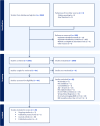Diagnosing neurodegenerative disorders using retina as an external window: A systematic review of OCT-MRI correlations
- PMID: 40255034
- PMCID: PMC12231815
- DOI: 10.1177/13872877251331231
Diagnosing neurodegenerative disorders using retina as an external window: A systematic review of OCT-MRI correlations
Abstract
BackgroundRecent studies have explored optical coherence tomography (OCT) and OCT-angiography (OCT-A) as biomarkers for Alzheimer's disease (AD). However, correlations between OCT/OCT-A and neurodegeneration metrics remain underexplored.ObjectiveWe performed a systematic review of OCT/OCT-A and structural brain imaging using MRI across various neurodegenerative disorders.MethodsWe searched Medline, Embase, and various other databases from January to June 2023 using keywords regarding neurodegenerative conditions and OCT/OCT-A. Out of 2962 citations. 93 articles were reviewed, and 28 met our inclusion criteria.ResultsLayer-or-region-specific retinal metrics were the most promising for non-vascular neurodegeneration, while vascular retinal parameters had the unique capacity to reflect vascular lesions. Both types of biomarkers correlated with global brain atrophy. Microstructural brain alterations best correlated with layer-specific thinning of retina.ConclusionsA better understanding of associations between retinal and brain lesions could eventually lead to the clinical application of retinal biomarkers for the early diagnosis of neurodegenerative conditions.
Keywords: Alzheimer's disease; cognitive decline; correlation; diffusion tensor imaging; magnetic resonance imaging; neurodegeneration; optical coherence tomography; optical coherence tomography – angiography; retinal biomarker; vascular dementia.
Conflict of interest statement
Declaration of conflicting interestsThe author(s) declared the following potential conflicts of interest with respect to the research, authorship, and/or publication of this article: Caroline Dallaire-Théroux is an Editorial Board Member of this journal but was not involved in the peer-review process of this article nor had access to any information regarding its peer-reviewJean-Paul Soucy collaborated on the preclinical studies at
Figures
References
-
- Emmady PD, Schoo C, Tadi P. Major neurocognitive disorder (dementia). StatPearls. Treasure Island, FL: StatPearls Publishing, LLC, 2024. - PubMed
-
- Saba L, Aarsland D, Akhlaghi H, et al. Imaging in Neurodegenerative Disorders. Oxford: Oxford University Press, 2015.
-
- Sevigny J, Chiao P, Bussière T, et al. The antibody aducanumab reduces Aβ plaques in Alzheimer’s disease. Nature 2016; 537: 50–56. - PubMed
-
- van Dyck CH, Swanson CJ, Aisen P, et al. Lecanemab in early Alzheimer's disease. N Engl J Med 2023; 388: 9–21. - PubMed
Publication types
MeSH terms
LinkOut - more resources
Full Text Sources
Medical
Miscellaneous




